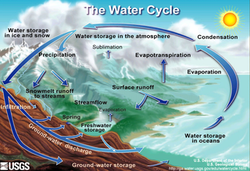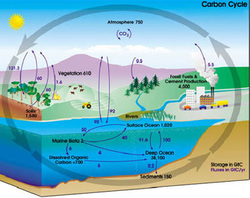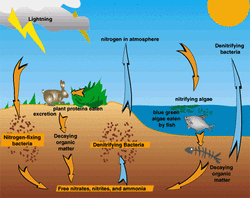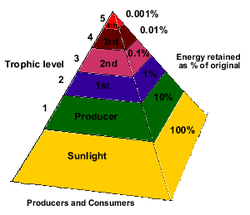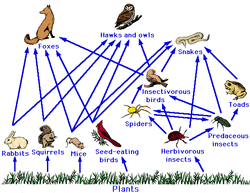Ecosystems
An ecosystem is an association of organisms and their physical environment, interconnected by an ongoing flow of energy and cycling of materials through it. It is an open system, with inputs, internal transfers, and outputs of energy and nutrients.
Nature of Ecosystems
Primary Producers
Primary producers are autotrophs. They are in the 1st trophic level.
Consumers
Consumers are heterotrophs that feed on cells or other tissues of other organisms for carbon and energy. Consumers can be herbivores, carnivores, or omnivores.
Decomposers
Decomposers are a fungal or bacterial heterotroph which nonliving products and remains of producers and consumers feed. They obtain carbon and energy from remains, products, or wastes of organisms. They help cycle nutrients to producers in ecosystems.
Detritivores
Detritivores are heterotrophs, but they ingest decomposing bits of organic matter. An example of a detritivore would be an earthworm.
Energy
Primary Productivity
Primary productivity is the rate at which primary producers capture and store a given amount of energy in their tissues during some specified interval.
Ecological Pyramids
- Biomass pyramid: depicts the weight of all the members at every tier
- Energy pyramid: portrays the diminishing flow of usable energy through an ecosystem
Biogeochemical Cycles
There are three categories of biogeochemical cycles: hydrologic cycles, atmospheric cycles, and sedimentary cycles. Hydrologic cycles are when oxygen and hydrogen move in the form of water molecules. Atmospheric cycles are when a larger percentage of the nutrient is in the form of an atmospheric gas. A sedimentary cycle involves phosphorus and other solid nutrients that do not have a gaseous forms.
Water Cycle
The water cycle is a hydrologic cycle. A hydrologic cycle is a biogeochemical cycle, driven by solar energy, in which water moves through the atmosphere, on or through land, to the ocean, and back to the atmosphere.
Carbon Cycle
The carbon cycle is an atmospheric cycle, where carbon moves from its largest reservoirs (sedimente, rocks, and the ocean), through the atmosphere, through food webs, and back to the reservoirs.
Nitrogen Cycle
The nitrogen cycle is also another atmospheric cycle, where nitrogen moves from its largest reservoir (atmosphere), through the ocean, ocean sediments, soils, and food webs, then back to the atmosphere.
Phosphorus Cycle
The phosphorus cycle is the movement of phosphorus (mainly phosphate ions) from land, through food webs, to ocean sediments, then back to land.
Greenhouse Gases
- Greenhouse effect: overall warming of lower atmosphere; gaseous molecules impede the escape of infrared wavelengths from the Earth's sunlight-warmed surface; these gases continually absorb those wavelengths and radiate much of their energy back toward Earth
- Global Warming: long-term higher temperatures at the Earth's surface
Structure of Ecosystems
Trophic Levels
Trophic levels of an ecosystem, all organisms that are the same number of transfer steps away from the energy input into the system. There are 5 trophic levels. (Other information can be found in the images below)
- (bottom of the pyramid) Closest to the energy input, plants and other producers
- primary consumers, grasshoppers and earthworms
- carnivores and parasites, 2nd level consumers
- carnivores and parasites, 3rd level consumers
- (top of the pyramid) Farthest from the energy input, top carnivores, 4th level consumers
Food Web vs. Food Chain
A food chain is a straight-line sequence of who eats whom in an ecosystem. A food web is a cross-connecting, interlinked food chains consisting of producers, consumers, and decomposers, detritivores, or both. There are two types of food webs: grazing food webs and detrital food webs. A grazing food web flows from photoautotrophs to herbivores, then through carnivores. A detrital food web flows from photoautotrophs through detritivores and decomposers.

